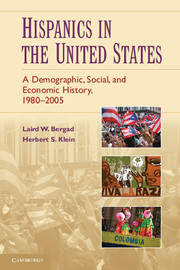Book contents
- Frontmatter
- Contents
- List of Graphs, Tables, and Maps
- Introduction
- 1 Immigration to the United States to 1980
- 2 The Hispanic Population to 1980
- 3 Population Growth and Dispersion, 1980–2005
- 4 The Demography of the Hispanic Population
- 5 Wealth and Poverty
- 6 Educational Attainment
- 7 Citizenship, the Latino Electorate, and Voter Participation
- 8 Occupational Structures, Employment, and Unemployment
- 9 English Language Abilities and Domestic Usage
- 10 Hispanic Business Ownership
- 11 Race
- 12 Endogamous and Exogamous Marriage Patterns among Latino Household Heads
- 13 Conclusion
- Bibliography
- Index
- References
3 - Population Growth and Dispersion, 1980–2005
Published online by Cambridge University Press: 05 June 2012
- Frontmatter
- Contents
- List of Graphs, Tables, and Maps
- Introduction
- 1 Immigration to the United States to 1980
- 2 The Hispanic Population to 1980
- 3 Population Growth and Dispersion, 1980–2005
- 4 The Demography of the Hispanic Population
- 5 Wealth and Poverty
- 6 Educational Attainment
- 7 Citizenship, the Latino Electorate, and Voter Participation
- 8 Occupational Structures, Employment, and Unemployment
- 9 English Language Abilities and Domestic Usage
- 10 Hispanic Business Ownership
- 11 Race
- 12 Endogamous and Exogamous Marriage Patterns among Latino Household Heads
- 13 Conclusion
- Bibliography
- Index
- References
Summary
Between 1980 and 2005 the Hispanic-origin population of the United States grew at a faster rate than any of the other nation's racial or ethnic components. Latinos also increased as a percentage of the total population and surpassed African Americans as the country's largest minority group. From a population of slightly more than 14.8 million in 1980, Hispanics nearly tripled to more than 43.1 million in 2005. Latinos accounted for 6.5% of the U.S. population in 1980 and for 14.5% in 2005 (see Table 3.1).
Between 1980 and 2005 the overall population of the United States grew by over 69 million people. About 41% of the total, some 28 million people, was comprised of Hispanics. The role of Hispanics in U.S. population expansion intensified after 2000. From 2000 to 2005 the total population of the United States increased by approximately 15 million persons. About half of this population expansion, or nearly 7.8 million people, was of Hispanic origin. The U.S. Census Bureau has estimated that, if these trends continue, Hispanics will account for about 21% of the overall population of the United States in 2025 and 30% in 2050.
- Type
- Chapter
- Information
- Hispanics in the United StatesA Demographic, Social, and Economic History, 1980–2005, pp. 63 - 98Publisher: Cambridge University PressPrint publication year: 2010



